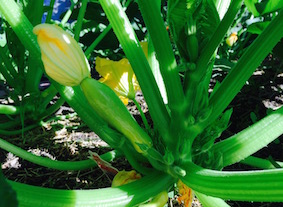Dealing with Squash Vine Borer
Views: 3166

Two weeks ago, I had gone away for a week-long vacation, leaving a friend in charge of watering my community garden patch. When I returned on Monday, I gave the garden a good watering later that afternoon. One of the Da Vinci melons (one of three that I nurtured from seed) looked a bit wilty. Ah, I thought, she couldn’t quite get this plant with the hose because it has large leaves. I gave it extra-special attention that afternoon.
The next morning, I noticed the plant looked no better. The leaves did have some developing powdery mildew that I hadn’t really paid attention to the day before. Could that have something to do with it? I snapped a photo and posted to Facebook with an inquiry about powdery mildew and wilting.
It just needs a good watering, the hot weather is to blame, and similar responses were the replies. Except for one. This looks a bit like squash vine borer, they make plants wilt suddenly. Uh oh.
Some Googling turned up an ugly insect and an even uglier larva. I hadn’t noticed either of them in or around the plant. It’s when I saw the videos that I knew I was onto something that sounded awfully familiar.
What is squash vine borer?
The squash vine borer adult lays eggs on the vine of squashes, zucchinis, cukes, melons. As the eggs develop, they drill down through the vine to enter the circulatory system of the plant. One of the signs of their presence is a small hole that looks like someone has just drilled a screw into a piece of wood, like a hole with wood shavings mounded around it. THIS was something that sounded familiar, not this year, but in past years. I always thought it was just ants? I had seen ants around these wounds but thought they weren’t causing any harm.
Turns out these squash vine borer larvae eat their way inside the vine and just keep eating, tunneling their way through the length of the vine. Tunnel enough, and the plant will lose the ability to transport water and nutrients to the leaves, resulting in the plant’s sudden wilt. In previous years I had seen the entry wound on zucchini, but it hadn’t resulted in wilt.
This year was a different matter. The melon wilted. I investigated the wilting melon plant and indeed found larvae inside. That’s plural, I found five of them. And I squished all five. Not pretty. The plant was a goner, and so were the four melons that weren’t quite ripe.
Removing squash vine borer
I looked for and found signs of squash vine borer on the other melons. I did a little surgery on the plants and pulled out the larvae. My Googling had said it’s possible to remove them, cover up the vine, and hope that the plant will be sparked into rooting from along that portion of vine. So, I covered up the vines. Not sure if they are rooting under there, but two weeks later the plants are still looking good.
I also found some squash vine borer larvae in my squash and zucchini plants. More surgery, more covering. Remember, I had seen those wood shavings last year but with no resulting wilt. Maybe melons are more susceptible to being tunneled through. I’m not sure of the reason they succumbed sooner. Just yesterday I pulled four more larvae from my squash and zukes. I’ll have to keep an eye out for new holes, although it may be past the adults’ egg-laying time.
Next task? Learn how to prevent them in the first place.
Meet Ellen Wells
When you’re raised on a farm, you can’t help but know a thing or two about gardening. Ellen Wells is our expert on edible gardening.…
Ellen's Recent Posts

Asparagus






